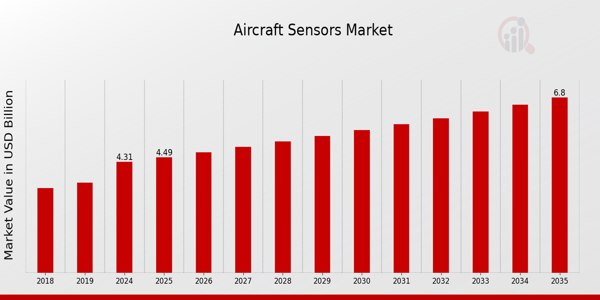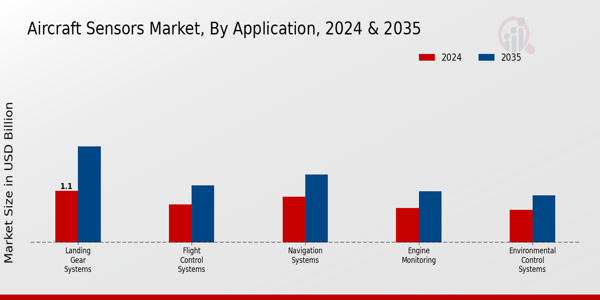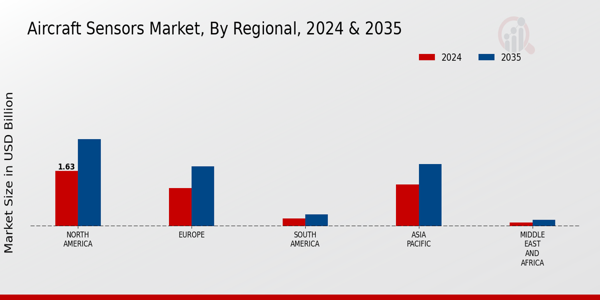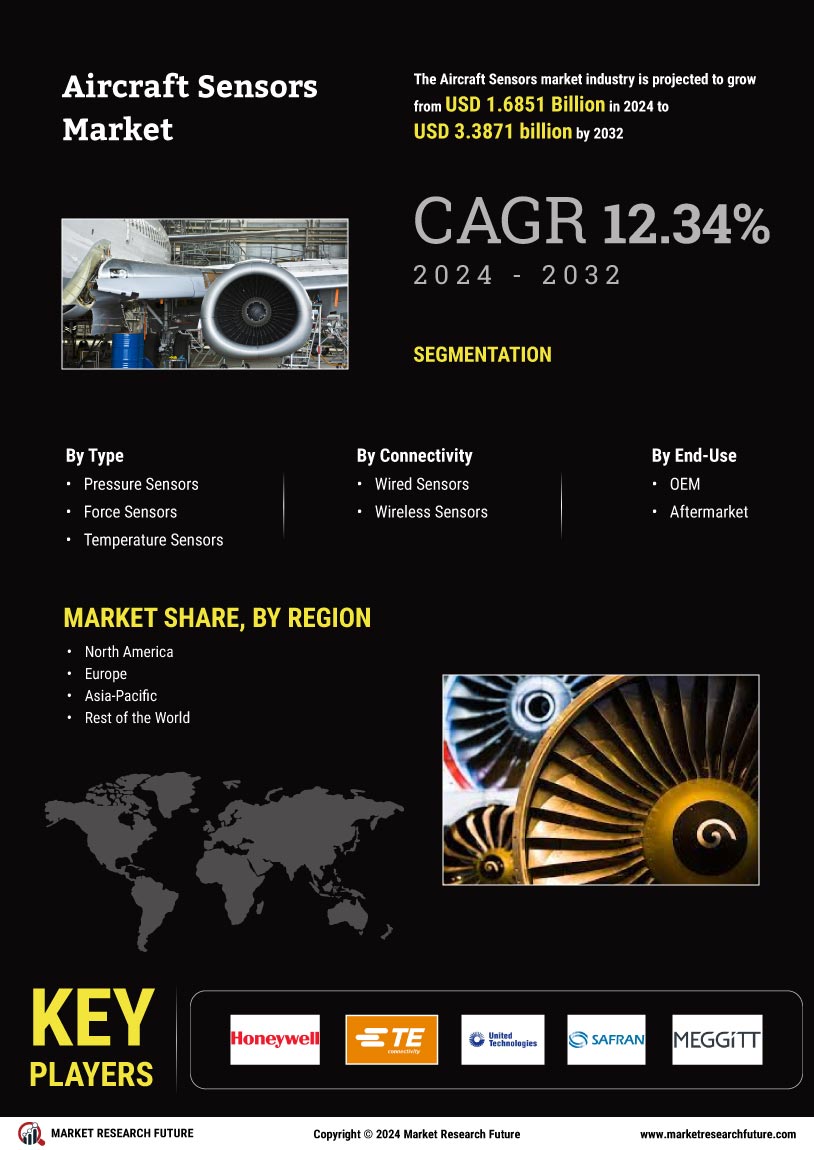Global Aircraft Sensors Market Overview
As per MRFR analysis, the Aircraft Sensors Market Size was estimated at 4.13 (USD Billion) in 2023. The Aircraft Sensors Market is expected to grow from 4.31 (USD Billion) in 2024 to 6.8 (USD Billion) by 2035. The Aircraft Sensors Market CAGR (growth rate) is expected to be around 4.23% during the forecast period (2025 - 2035).
Key Aircraft Sensors Market Trends Highlighted
Several technical and regulatory improvements are now driving key trends in the Aircraft Sensors Market. These trends are currently being experienced by the market. The growing emphasis on improving airplane safety and operating efficiency is a prominent market driver that is seeing substantial growth.
Regulatory agencies all over the globe are placing a greater emphasis on more stringent safety regulations, which is leading manufacturers to increase their investments in advanced sensor technologies that are able to monitor a variety of data in real time, including temperature, speed, and altitude.
The transformation of sensor capabilities is also being brought about by the growing usage of sophisticated technologies such as the Internet of Things (IoT) and artificial intelligence (AI). This is making it possible to do predictive maintenance and enhance diagnostics.
In recent years, there has been a trend toward the use of intelligent sensors that are not only lightweight but also efficient in terms of energy consumption. This tendency is in line with the initiative taken by the global aviation sector to lessen its impact on the environment by lowering carbon emissions and increasing fuel economy.
Furthermore, there is a rising need for retrofitting old airplanes with contemporary sensors in order to improve their performance and ensure that they are in conformity with the rules that are already in place.
The growing demand for unmanned aerial vehicles (UAVs) and electric aircraft, both of which require advanced sensor technologies for effective navigation and operation, is one of the opportunities that may be explored in the global market for aviation sensors.
In addition, the continual development of sensor networks that are capable of providing extensive data analysis and improving decision-making processes is a promising sector for the expansion of the market.
There will be an ever-increasing need for superior aircraft sensor systems as governments all over the world continue to spend in developing and updating their aviation infrastructure. This will create a multitude of opportunities for innovation and market development.

Source: Primary Research, Secondary Research, Market Research Future Database and Analyst Review
Aircraft Sensors Market Drivers
Increase in Aircraft Production and Deliveries
The Aircraft Sensors Market is expected to witness significant growth driven by the increasing production and delivery of aircraft. According to the International Air Transport Association, global passenger numbers are set to reach 8.2 billion by 2037, which will necessitate the construction of new aircraft to accommodate this expansion.
This rise in demand for new aircraft is fuelling the need for advanced sensor technology to ensure safety, enhance performance, and improve fuel efficiency.
Established manufacturers such as Boeing and Airbus are ramping up production to meet this demand, with reports indicating that they plan to deliver approximately 45,000 new jets over the next two decades. As aircraft production increases, so does the integration of sophisticated sensors for monitoring aircraft systems, positioning the Aircraft Sensors Market for substantial growth.
Technological Advancements in Sensor Technologies
Another prominent driver for the Aircraft Sensors Market is the rapid advancement in sensor technologies. The rise of Internet of Things (IoT) applications in aviation has led to the development of smart sensors that can provide real-time data and analytics for more effective decision-making.
Companies such as Honeywell and Siemens are at the forefront of innovation, developing next-generation sensors that enhance aircraft capabilities while reducing operational costs.
According to government reports, the adoption of new sensor technologies has improved aircraft efficiency by as much as 12%, reducing operational costs significantly. This technological evolution is boosting the market as airlines and manufacturers seek to capitalize on these innovations.
Regulatory Compliance and Safety Standards
Stringent regulatory compliance and safety standards enforced by authorities such as the Federal Aviation Administration (FAA) and the European Union Aviation Safety Agency (EASA) are driving the Aircraft Sensors Market.
These agencies have mandated the implementation of advanced sensor systems to monitor various aircraft parameters, ensuring the safety and efficiency of air travel. Reports indicate that the regulatory environment has necessitated that manufacturers integrate state-of-the-art sensors into new aircraft designs, which contributes to the projected growth in sensor demand.
It is estimated that compliance with these regulations can increase operational safety by up to 30%, prompting significant investments in sensor technologies across the industry.
Aircraft Sensors Market Segment Insights
Aircraft Sensors Market Application Insights
The Aircraft Sensors Market, focusing on the Application segment, showcased a robust valuation that highlights the increasing reliance on advanced sensor technologies in aviation.
The Application segment can be seen as a backbone of modern aviation safety and efficiency, featuring critical applications such as Flight Control Systems, Engine Monitoring, Environmental Control Systems, Navigation Systems, and Landing Gear Systems.
Among these, Flight Control Systems emerged as a dominant category, valued at 0.812 billion USD in 2024, indicating its crucial role in ensuring aircraft stability and maneuverability, and is projected to grow significantly to 1.213 billion USD by 2035.
Engine Monitoring also played a vital role in enhancing operational efficiency and reducing maintenance costs, with a market value of 0.731 billion USD in 2024, expected to rise to 1.09 billion USD by 2035.
Environmental Control Systems, valued at 0.69 billion USD in 2024, emphasized the importance of maintaining passenger comfort and air quality, projected to grow to 1.005 billion USD by 2035, reflecting a growing focus on cabin standards.
Navigation Systems, an essential component supporting safe and efficient flight operations, were at 0.974 billion USD in 2024 and are expected to reach 1.445 billion USD by 2035. Lastly, Landing Gear Systems, valued at 1.104 billion USD in 2024, are anticipated to grow to 2.048 billion USD by 2035, demonstrating their significant contribution to safe aircraft landing and takeoff processes.
The substantial investments in these areas underscored a strong trend towards modernization and safety improvements in aviation, driven by technological advancements and regulatory requirements. The overall growth prospects within these applications represent not only a response to rising air traffic but also indicate an ongoing commitment to enhancing aircraft performance, safety, and operational efficiency.
As such, the Aircraft Sensors Market segmentation showcases a variety of applications that are essential for both current and future aviation industry advancements.

Source: Primary Research, Secondary Research, Market Research Future Database and Analyst Review
Aircraft Sensors Market Sensor Type Insights
The Aircraft Sensors Market is a crucial component of the aerospace industry. Sensor Type plays a vital role in enhancing aircraft performance and safety, as various sensor types including Pressure Sensors, Temperature Sensors, Position Sensors, Speed Sensors, and Acceleration Sensors are employed for critical monitoring and control applications.
Pressure Sensors are pivotal for measuring cabin pressure, ensuring passenger comfort, while Temperature Sensors monitor engine performance and environmental conditions. Position Sensors facilitate accurate navigation and stability, which is significant in complex flight maneuvers.
Speed Sensors provide vital data for optimal fuel efficiency and safety margins, making them indispensable. Additionally, Acceleration Sensors are essential for analyzing dynamic forces acting on the aircraft, contributing to improved designs and safety protocols.
As the Aircraft Sensors Market experiences steady growth, driven by innovations in sensor technology and increasing demand for advanced aircraft systems, understanding the role of these sensors becomes integral for stakeholders looking to optimize performance and comply with safety regulations.
The focus on precision, reliability, and the integration of smart technologies positions the sensor segment as a cornerstone of future advancements in the aerospace industry.
Aircraft Sensors Market End-use Insights
The market is primarily influenced by factors such as technological advancements, enhanced safety regulations, and rising air traffic globally. Commercial Aviation holds a significant portion of the market, reflecting the growing need for reliable sensors to ensure aircraft performance and safety.
Military Aviation is also crucial, as defense budgets increase worldwide, leading to the adoption of advanced sensors for surveillance and reconnaissance purposes. General Aviation benefits from increasing private travel and the use of light aircraft, necessitating modern sensor solutions for better operational efficiency.
Business Aviation remains vital for corporate travel; companies increasingly invest in more efficient and safe aircraft, highlighting the importance of sensor technology. Overall, the segmentation of the Aircraft Sensors Market emphasizes the crucial role of different End-uses, aligning with the diverse requirements for safety, monitoring, and performance optimization across the aviation industry.
Rising demand in each of these sectors underscores the growth opportunities inherent in the Aircraft Sensors Market, with data reflecting an overall market growth trend in the years to come.
Aircraft Sensors Market Platform Insights
The platform segment encompasses critical categories such as Fixed-Wing Aircraft, Rotary-Wing Aircraft, and Unmanned Aerial Vehicles, each contributing uniquely to market dynamics. Fixed-Wing Aircraft are primarily driven by their notable efficiency in long-distance travel and cargo transport.
Rotary-Wing Aircraft play a significant role in versatility for operations in confined spaces and rugged terrains, making them indispensable for both military and rescue missions. Unmanned Aerial Vehicles are rapidly gaining prominence, especially in surveillance and logistics, serving as a key driver of innovation in the industry.
The growing demand for air travel and the modernization of aging aircraft fleets underscore the significance of the Aircraft Sensors Market segmentation, as these technologies enhance safety, efficiency, and performance across all platforms.
The continuous improvements in sensor technologies present ample opportunities for growth, despite challenges such as regulatory compliance and the high cost associated with sensor integration.
Aircraft Sensors Market Regional Insights
North America led this market, valued at 1.63 USD Billion in 2024 and anticipated to reach 2.56 USD Billion by 2035, primarily due to its advanced aerospace industry and high demand for innovative sensor technologies. Europe followed, with a valuation of 1.12 USD Billion in 2024 and expected growth to 1.76 USD Billion in 2035, driven by stringent regulations and a focus on enhancing safety measures in aviation.
The Asia Pacific region, with a valuation of 1.22 USD Billion in 2024, showed strong potential for growth as it benefited from increasing air travel and investment in modernizing aviation infrastructure, reaching 1.82 USD Billion by 2035.
South America, although smaller with a valuation of 0.23 USD Billion, is projected to grow to 0.35 USD Billion due to emerging market dynamics. The Middle East and Africa, starting at 0.11 USD Billion and expected to increase to 0.19 USD Billion, reflected growth opportunities through expanding air transport networks.
Each of these regions presented distinct opportunities, influenced by factors such as technological advancements and regulatory frameworks, making them crucial players in the Aircraft Sensors Market.

Source: Primary Research, Secondary Research, Market Research Future Database and Analyst Review
Aircraft Sensors Market Key Players and Competitive Insights
The Aircraft Sensors Market is characterized by an increasing demand for advanced sensing technologies that ensure the safety, reliability, and efficiency of aviation operations. As technological advancements continue to shape the future of the aerospace industry, manufacturers and suppliers of aircraft sensors are actively competing to develop innovative solutions that enhance functionality.
This competitive landscape involves various players focused on meeting the stringent regulatory standards and evolving requirements of aircraft systems. The market is marked by a diverse range of sensor applications, including but not limited to environmental monitoring, flight control, and navigation, all contributing to the overall performance of aircraft systems.
Companies that effectively leverage their technological expertise and market strategies are likely to gain a significant edge in this rapidly growing sector.
BAE Systems has solidified its presence in the Aircraft Sensors Market through its commitment to innovation and quality. Renowned for its extensive research and development efforts, BAE Systems leverages cutting-edge technology to produce a diverse array of sensors tailored for aircraft applications.
The company’s strengths lie in its robust supply chain capabilities, strong customer relationships, and a comprehensive understanding of regulatory compliance, which enables it to deliver high-performance products.
BAE Systems also emphasizes collaboration with aerospace manufacturers and government agencies, allowing it to stay ahead of market trends and technological advancements, thereby ensuring its competitive position in the global market.
Moog has established itself as a key player in the Aircraft Sensors Market, offering a broad portfolio of products, including motion control and sensors for navigation and flight systems. The company's strength lies in its ability to provide highly specialized solutions that cater to the unique demands of the aerospace sector.
Moog's extensive global reach ensures a consistent market presence, allowing it to serve a wide range of customers effectively. Moreover, Moog has been active in pursuing mergers and acquisitions, aimed at expanding its capabilities and enhancing its product offerings in response to evolving industry needs.
By focusing on innovation, Moog not only reinforces its strengths in manufacturing precision sensors but also positions itself strategically to succeed in a competitive landscape driven by technological advancements and regulatory changes.
Key Companies in the Aircraft Sensors Market Include
BAE Systems
Moog
Collins Aerospace
General Electric
CurtissWright
Sensata Technologies
Thales
Textron
Northrop Grumman
Honeywell
Raytheon Technologies
Siemens
Rockwell Collins
Eaton
Safran
Aircraft Sensors Market Developments
The Aircraft Sensors Market has been witnessing significant advancements and developments, with BAE Systems and Honeywell frequently innovating in sensor technologies to enhance aircraft performance and safety.
Recent reports suggest a notable increase in market valuation for companies like General Electric and Collins Aerospace, reflecting the rising demand for advanced sensors in commercial and military aviation. In terms of mergers and acquisitions, Moog announced its acquisition of Aircraft Sensors in September 2023, a strategic move to bolster its position in the market.
Sensata Technologies and Thales have also strengthened partnerships, focusing on sensor integration for next-generation aircraft. The push for innovation is driven by a growing emphasis on fuel efficiency and safety regulations globally, prompting companies like Northrop Grumman and Raytheon Technologies to invest heavily in Research and Development.
The aviation industry's recovery post-pandemic has further fueled demand, with Siemens and Eaton expanding their product lines to cater to evolving market needs. Additionally, in late 2022, Safran secured a multi-year contract to supply sensors for a major aerospace manufacturer, illustrating the ongoing evolution and competitive landscape within the Aircraft Sensors Market.
Aircraft Sensors Market Segmentation Insights
Aircraft Sensors Market Application Outlook
Flight Control Systems
Engine Monitoring
Environmental Control Systems
Navigation Systems
Landing Gear Systems
Aircraft Sensors Market Sensor Type Outlook
Pressure Sensors
Temperature Sensors
Position Sensors
Speed Sensors
Acceleration Sensors
Aircraft Sensors Market End-use Outlook
Commercial Aviation
Military Aviation
General Aviation
Business Aviation
Aircraft Sensors Market Platform Outlook
Fixed-Wing Aircraft
Rotary-Wing Aircraft
Unmanned Aerial Vehicles
Aircraft Sensors Market Regional Outlook
North America
Europe
South America
Asia Pacific
Middle East and Africa
|
Report Attribute/Metric
|
Details
|
|
Market Size 2023
|
4.13(USD Billion)
|
|
Market Size 2024
|
4.31(USD Billion)
|
|
Market Size 2035
|
6.8(USD Billion)
|
|
Compound Annual Growth Rate (CAGR)
|
4.23% (2025 - 2035)
|
|
Report Coverage
|
Revenue Forecast, Competitive Landscape, Growth Factors, and Trends
|
|
Base Year
|
2024
|
|
Market Forecast Period
|
2025 - 2035
|
|
Historical Data
|
2019 - 2024
|
|
Market Forecast Units
|
USD Billion
|
|
Key Companies Profiled
|
BAE Systems, Moog, Collins Aerospace, General Electric, CurtissWright, Sensata Technologies, Thales, Textron, Northrop Grumman, Honeywell, Raytheon Technologies, Siemens, Rockwell Collins, Eaton, Safran
|
|
Segments Covered
|
Application, Sensor Type, End-use, Platform, Regional
|
|
Key Market Opportunities
|
Increased demand for safety features, Expansion in commercial aviation sector, Growth of unmanned aerial vehicles, Advances in sensor technology, Integration of IoT in aviation
|
|
Key Market Dynamics
|
Technological advancements, Increasing air travel demand, Regulatory compliance, Growing UAV applications, Enhanced safety requirements
|
|
Countries Covered
|
North America, Europe, APAC, South America, MEA
|
Aircraft Sensors Market Highlights:
Frequently Asked Questions (FAQ):
The Aircraft Sensors Market was valued at 4.31 billion USD in 2024.
By 2035, the Aircraft Sensors Market is anticipated to reach a value of 6.8 billion USD.
The expected CAGR for the Aircraft Sensors Market during the period from 2025 to 2035 is 4.23%.
North America is projected to hold the largest market share, expected to reach 2.56 billion USD by 2035.
The market size for Flight Control Systems is expected to reach 1.213 billion USD by 2035.
Major players include BAE Systems, Moog, Collins Aerospace, General Electric, and Honeywell, among others.
The Engine Monitoring segment of the Aircraft Sensors Market is projected to be valued at 1.09 billion USD by 2035.
Asia Pacific is expected to contribute approximately 1.82 billion USD to the market by 2035.
The Navigation Systems application in the Aircraft Sensors Market is expected to be valued at 1.445 billion USD by 2035.
Challenges may include technological advancements and regulatory compliance in an evolving aviation landscape.

















